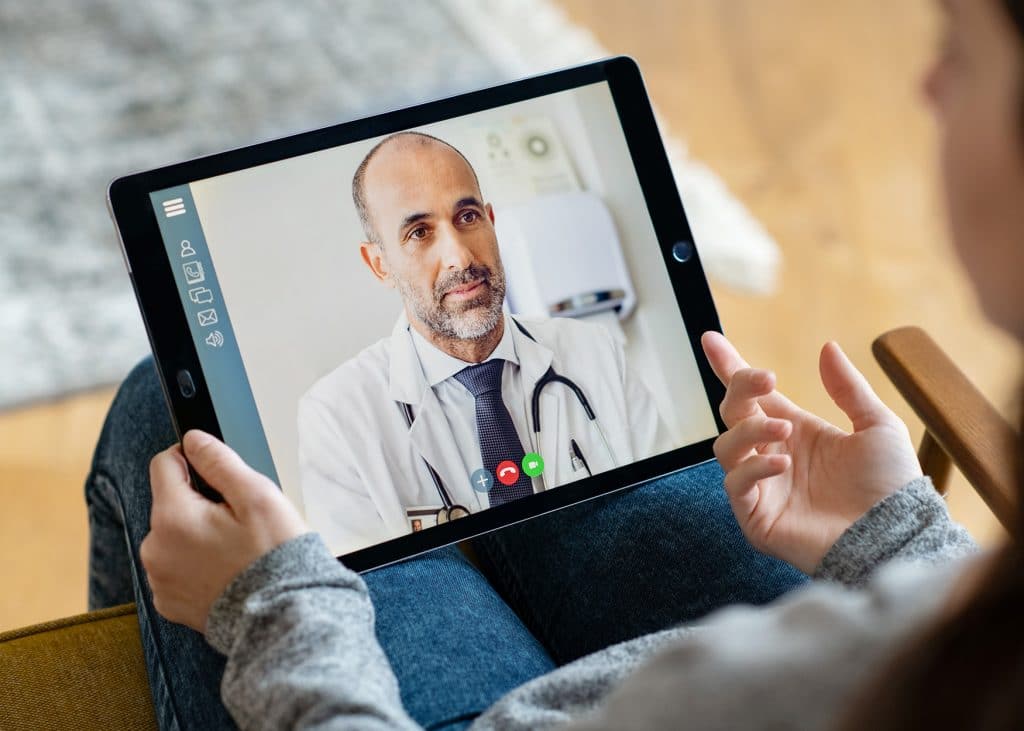
Virtual Care – A Viable Care Solution for Healthcare Players
With almost 50% hospitals in UAE already using technology and IoT solutions to provide health services, virtual care may just be a viable business proposition in the post pandemic world.


With almost 50% hospitals in UAE already using technology and IoT solutions to provide health services, virtual care may just be a viable business proposition in the post pandemic world.
We are moving towards a new world. One that got nudged just a bit more by the ongoing pandemic, towards virtual care. While telemedicine has always been a small part of care delivery, it is virtual care, a larger umbrella of services, that is now doing the rounds. Virtual care, simply put, is not episodic. It involves the whole gamut of services ranging from real-time interactions to post-treatment care and beyond.
C-suites at hospitals should now start considering virtual care seriously. The pandemic has pushed people to adopt digital care solutions, yes. However, to make the system sustainable in the future, a more efficient workflow should be devised.
Even now, we still find people wanting to personally meet their doctors for their healthcare needs. A certain percentage of patients will always need, require and demand such in-person care. Although, there are people who are open to virtual care, and those are the ones hospitals should tap first. The model can then move towards bringing other less-willing people in the ambit too (more on this perhaps in my next article).
As per studies, around 54% UAE population does prefer virtual healthcare services, especially for primary care. This number is 14% higher than the global average, and mainly forms expats (who are almost an 80% population in UAE).
Hospitals can look at various avenues in virtual care and fuse them with their current delivery model. Let us look at some of the viable options.
UAE has a high incidence of cardiovascular diseases, cancer, diabetes, chronic respiratory diseases, and obesity. NCDs are responsible for more than 70% deaths in the UAE, with the likelihood of premature death rate of 17%. Virtual care can tackle this burden. Providing virtual care for NDCs and chronic conditions is relatively easier, as a hospital visit is not required ever so often.
With various home monitoring devices available now a days, it has become fairly simple for patients to keep a track on their health. Not only this, hospitals can remotely monitor all such patients by being connected to the patient’s devices. With every spike or trough, the care team can be alerted and timely interventions can be effortlessly provided virtually.
Lifestyle disease management is purely managing the lifestyle, which can be smoothly achieved through virtual models. Regular diet, fitness, nutrition consultations can also be provided by hospitals easily.
Such integrations make the care delivery a seamless process for both hospitals and patients.
UAE’s high expat population is mostly young adults and couples. There are an estimated 1.46 million women in UAE (as per latest census), in the age group of 25-54. Considering the high number of expats, it is safe to assume a majority of this would be younger working women, who may at some point need maternity care. Hospitals can provide virtual maternal and gynae care for this segment of young women and mothers. Care options can include remote midwife care, nursing care, and doctor consultations when required.
You can also have a dedicated midwife or nurse for each patient, to provide them personalized care at all times. Due to the virtual nature of care, one nurse or midwife can handle many patients at the same time.
Such a model will optimize your resources, reduce the unnecessary hospital visits, save your physicians’ time to attend to higher number of patients. Also, lower the infection rates of patients and provide comfortable care to pregnant women later in their pregnancy term.
Not just expectant mothers, overall working men and women should be your target group, who generally would like to avoid a lengthy hospital visit, especially with their work schedules.
The model can extend to children too, of mothers who have already availed your hospital’s virtual care and also about 14 million other kids in the age group of 0-14 years in UAE. Once this young and/or expat population avails the benefits of your virtual care, you can also include their families in different countries. Generally, people prefer to avail healthcare in their home country. However, if a cost-effective virtual option is made available by their children, who have themselves experienced it, then the families and parents can be roped in too. Of course, for more urgent needs and surgical interventions, they can always avail care locally.



As per statistics, during the start of the pandemic, almost 60% teleconsultations in UAE were for mental health issues. While later, the figure dropped to around 23%. This data shows the need and the demand for mental health issues, and the openness of people to avail it through virtual means.
Hospitals in UAE can thus create a model for virtual psychiatry care, and extend it to a large set of services, and not just keep it confined to the pandemic.
As per a research, 86% of UAE’s workforce has reported mental issues due to stress and anxiety at work. Additionally, almost 30% suffer from burnout issues, around 41% from stress, roughly 39% lack work-life balance, 19% are affected by loneliness, about 91% cited stress affecting their home life.
Hospitals have a huge opportunity to service this segment through virtual care. Timely interventions are a must for tackling such challenges, and virtual care can provide just that, plus the privacy that most people in this bracket require.
The same research has highlighted that some 86% respondents would prefer interacting with a non-judgemental robot about their mental health issues. Thus, how about even having a robo-assisted model for a segment of such patients? Human interventions can be need-based; it is easy to use AI for detecting sensitive cases requiring human care.
A Harvard Business Review article mentions about a virtual visit pilot program at Brigham and Women’s Hospital, which yielded a 97% satisfaction rate among patients, with 74% stating that – the interaction actually improved their relationship with their provider. While approximately 600 virtual visits could free up about 200 hours for providers to see patients. A 15-minute office visit for urinary symptoms or cough could be done in under 5 minutes through this program. About 50% of specialist consultations could be avoided, as the general physician himself virtually consulted the specialist first. Resulting in greater generated capacity for complex and appropriate specialty care
Virtual care is all about timely interventions for patients and efficiency for hospitals. Hospitals can consider using virtual care for a set of urgent/emergency cases. Global data highlights that 2/3rd of the ER visits are usually avoidable. Imagine the kind of resources your hospital can save, if some of the emergency/urgent services are shifted to virtual care.
Not only will the care be faster delivered, but the accessibility will also increase. Some examples of this can be care for certain respiratory issues, pandemic related symptoms, dermatology problems like skin rashes, minor injuries, cuts, burns, and ortho problems, small dental issues, pink eyes, cold & flu, and more.
Virtual care can enable your hospital to cater to a wider patient base across the globe, with no boundations of a physical entity to provide care. Additionally, one should consider that almost 80% physicians and 90% nurses are expats in UAE. Hospitals can device a model, wherein certain remotely-manageable conditions are cared by doctors from their home countries. If implemented with enough data and analysis, it can be a great cost-saving measure for a UAE hospital. Moreover, providing a further revenue stream of global patients.

Virtual care sure is the buzz word. However, hospitals should only join the bandwagon with absolute clarity and a specific business plan in place. A hospital should know which clinical services it can offer virtually, the manpower available/arrangement for it, which models will create value for the hospital and the patients, and lastly, which technology platform will suit the hospital’s requirements best.
For the next FUH Medical Review
©2021 Fakeeh University Hospital. All Rights Reserved
To FUH Medical Review